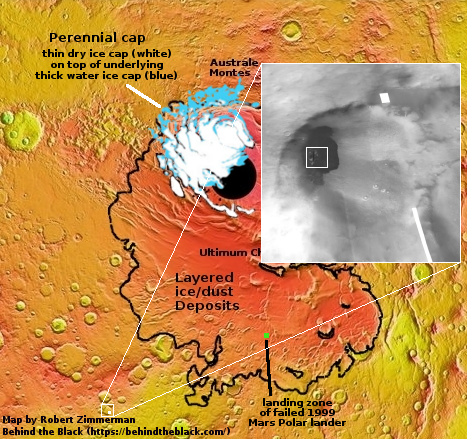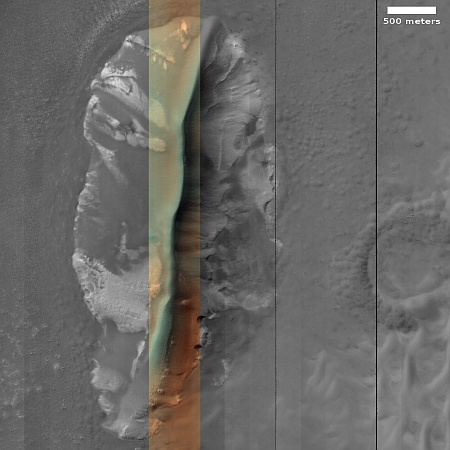A strange dune in the high southern latitudes of Mars
Cool image time! The picture to the right, rotated, cropped, reduced, and sharpened to post here, was taken on October 24, 2024 by the high resolution camera on Mars Reconnaissance Orbiter (MRO). I have also rotated the image so that north is to the top.
The scientists label this a “dune with seasonally persistent light-toned features.” As the location is in the high southern latitudes, only about 800 miles from the south pole, light-toned features should vary by seasons, as such features usually signal the coming and going of frost, whether it be water ice or dry ice. In this case however the light tones remain from season to season, which suggests the lighter colors are intrinsic to the ground and possibly signal some interesting geology or mineralogy.
The color strip down the center of the dune is an effort to decipher this question. According to the explanation about the colors [pdf] provided by the science team, the orange and light green probably indicates fine dust, while the greenish area along the ridge’s rim as well as its eastern slope suggests frost. Thus, based on the superficial information available to the public, the colors tell us little.

The white dot near the bottom of the overview map to the right marks the location, inside a small and heavily eroded small crater. In the inset, note the very dark and distinct material that surrounds this dune. At this high latitude such patches inside craters are usually light in color, and indicate glacial debris. In this case the dark color instead suggests volcanic ash. Why it should have gathered so distinctly in this one patch however is a mystery. If there was an eruption nearby it would have sprayed ash in many places, not just here.
Ash is only a guess. The dark material might be something else, and also might explain the persistent colors in the dune. Or it might not. It appears from both the image above and the inset that the dark material came after this dune, and simply covers its lower layers. In the high resolution image the material resembles glacial debris, but its dark color in the lower resolution inset remains a puzzle.
The white patches on the slopes of this dune thus remain a puzzle. They suggest some interesting mineralogy, but exactly what cannot be determined by the data on hand.
On Christmas Eve 1968 three Americans became the first humans to visit another world. What they did to celebrate was unexpected and profound, and will be remembered throughout all human history. Genesis: the Story of Apollo 8, Robert Zimmerman's classic history of humanity's first journey to another world, tells that story, and it is now available as both an ebook and an audiobook, both with a foreword by Valerie Anders and a new introduction by Robert Zimmerman.
The print edition can be purchased at Amazon or from any other book seller. If you want an autographed copy the price is $60 for the hardback and $45 for the paperback, plus $8 shipping for each. Go here for purchasing details. The ebook is available everywhere for $5.99 (before discount) at amazon, or direct from my ebook publisher, ebookit. If you buy it from ebookit you don't support the big tech companies and the author gets a bigger cut much sooner.
The audiobook is also available at all these vendors, and is also free with a 30-day trial membership to Audible.
"Not simply about one mission, [Genesis] is also the history of America's quest for the moon... Zimmerman has done a masterful job of tying disparate events together into a solid account of one of America's greatest human triumphs."--San Antonio Express-News
Cool image time! The picture to the right, rotated, cropped, reduced, and sharpened to post here, was taken on October 24, 2024 by the high resolution camera on Mars Reconnaissance Orbiter (MRO). I have also rotated the image so that north is to the top.
The scientists label this a “dune with seasonally persistent light-toned features.” As the location is in the high southern latitudes, only about 800 miles from the south pole, light-toned features should vary by seasons, as such features usually signal the coming and going of frost, whether it be water ice or dry ice. In this case however the light tones remain from season to season, which suggests the lighter colors are intrinsic to the ground and possibly signal some interesting geology or mineralogy.
The color strip down the center of the dune is an effort to decipher this question. According to the explanation about the colors [pdf] provided by the science team, the orange and light green probably indicates fine dust, while the greenish area along the ridge’s rim as well as its eastern slope suggests frost. Thus, based on the superficial information available to the public, the colors tell us little.

The white dot near the bottom of the overview map to the right marks the location, inside a small and heavily eroded small crater. In the inset, note the very dark and distinct material that surrounds this dune. At this high latitude such patches inside craters are usually light in color, and indicate glacial debris. In this case the dark color instead suggests volcanic ash. Why it should have gathered so distinctly in this one patch however is a mystery. If there was an eruption nearby it would have sprayed ash in many places, not just here.
Ash is only a guess. The dark material might be something else, and also might explain the persistent colors in the dune. Or it might not. It appears from both the image above and the inset that the dark material came after this dune, and simply covers its lower layers. In the high resolution image the material resembles glacial debris, but its dark color in the lower resolution inset remains a puzzle.
The white patches on the slopes of this dune thus remain a puzzle. They suggest some interesting mineralogy, but exactly what cannot be determined by the data on hand.
On Christmas Eve 1968 three Americans became the first humans to visit another world. What they did to celebrate was unexpected and profound, and will be remembered throughout all human history. Genesis: the Story of Apollo 8, Robert Zimmerman's classic history of humanity's first journey to another world, tells that story, and it is now available as both an ebook and an audiobook, both with a foreword by Valerie Anders and a new introduction by Robert Zimmerman.
The print edition can be purchased at Amazon or from any other book seller. If you want an autographed copy the price is $60 for the hardback and $45 for the paperback, plus $8 shipping for each. Go here for purchasing details. The ebook is available everywhere for $5.99 (before discount) at amazon, or direct from my ebook publisher, ebookit. If you buy it from ebookit you don't support the big tech companies and the author gets a bigger cut much sooner.
The audiobook is also available at all these vendors, and is also free with a 30-day trial membership to Audible.
"Not simply about one mission, [Genesis] is also the history of America's quest for the moon... Zimmerman has done a masterful job of tying disparate events together into a solid account of one of America's greatest human triumphs."--San Antonio Express-News



Just guessing, but the green-ish sands could contain chlorites rich in (iron-aluminium-phyllosilicate) like chamosite, or even glauconite (iron-potassium-phyllosilicate). Mars continues to be a ‘box of chocolates’.